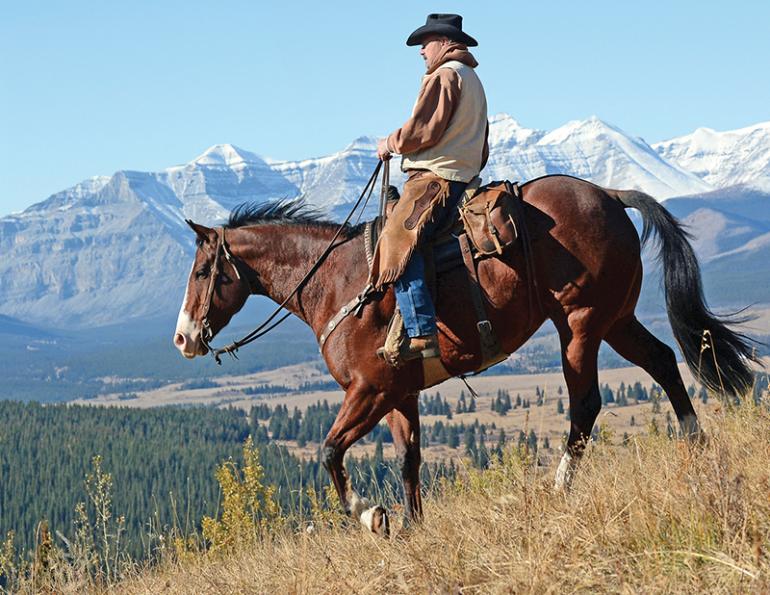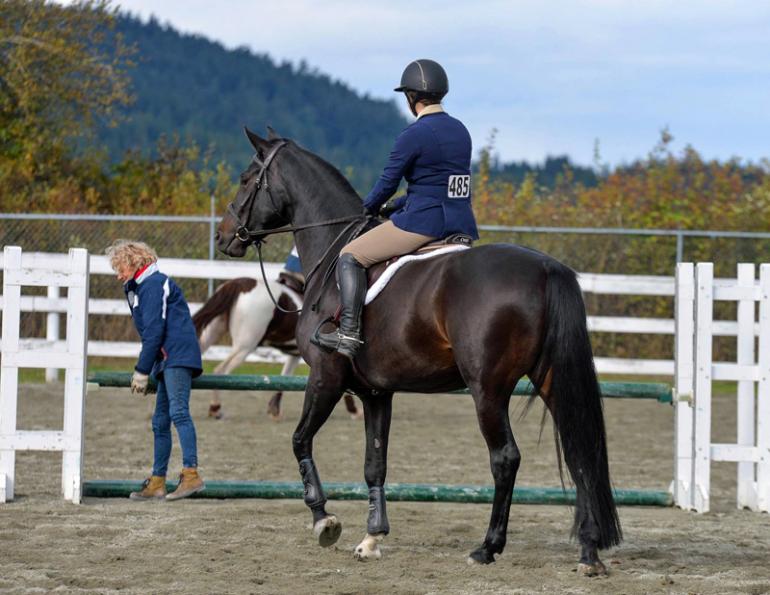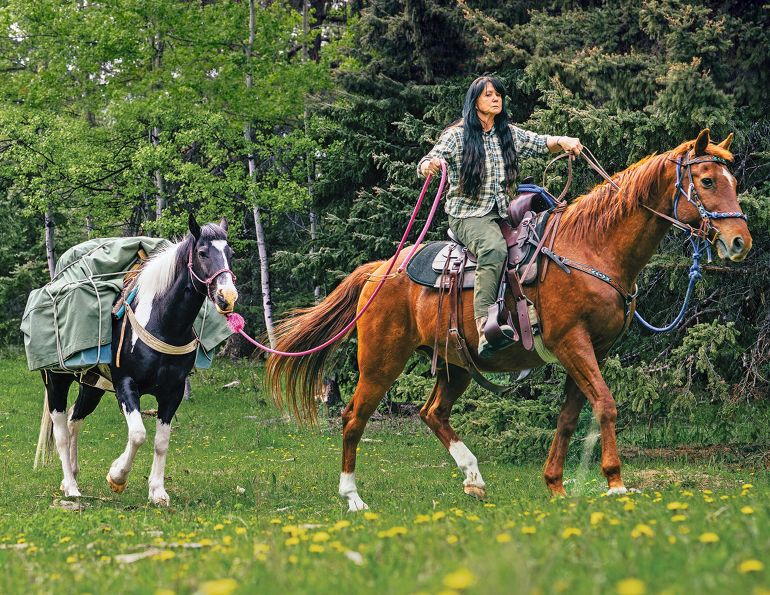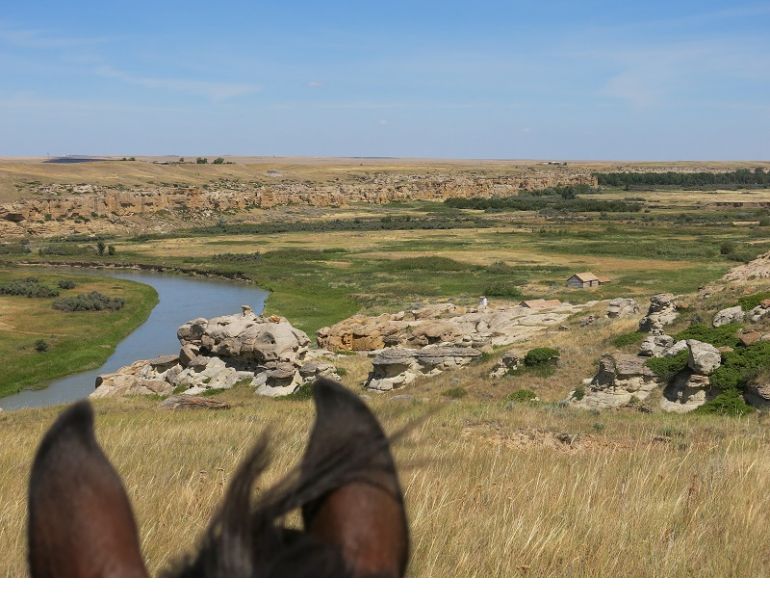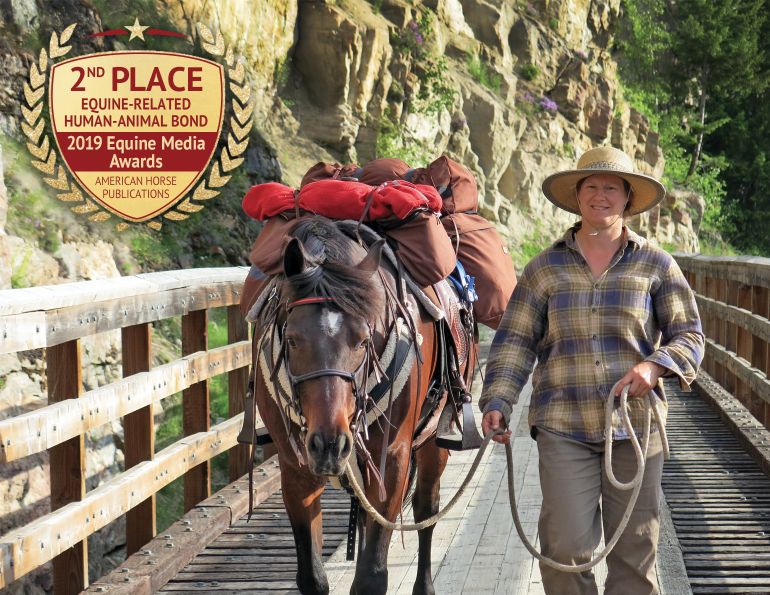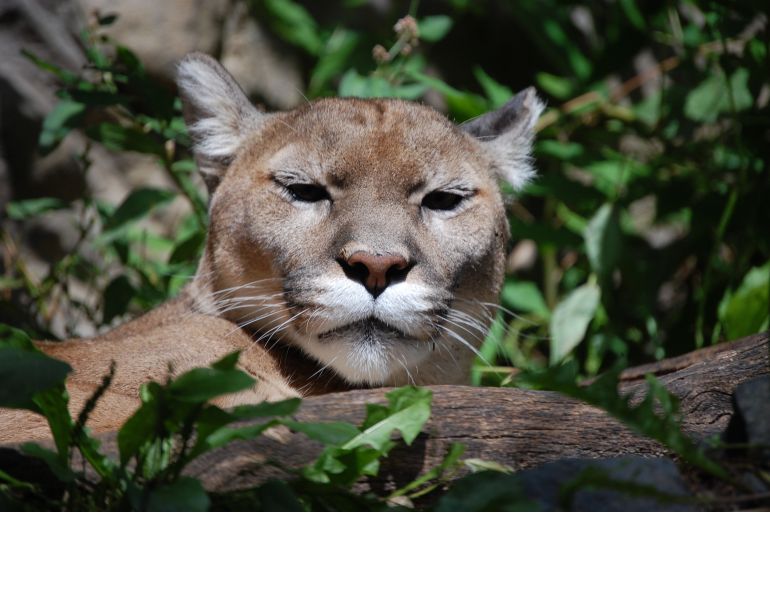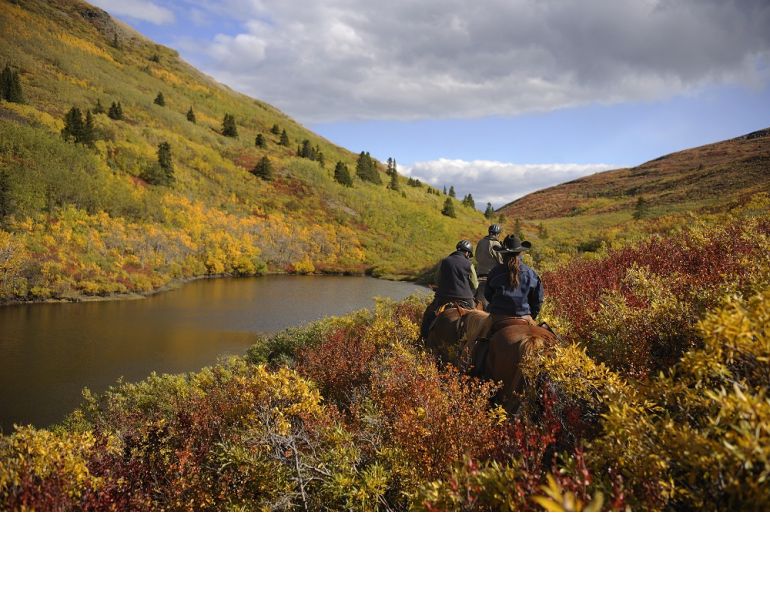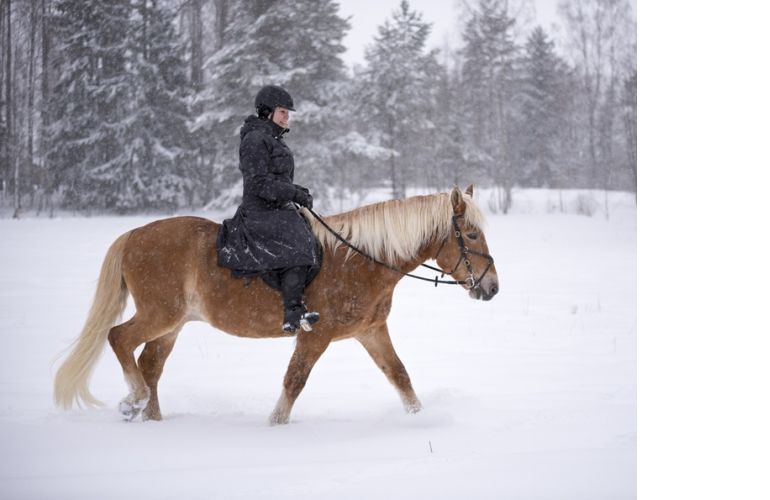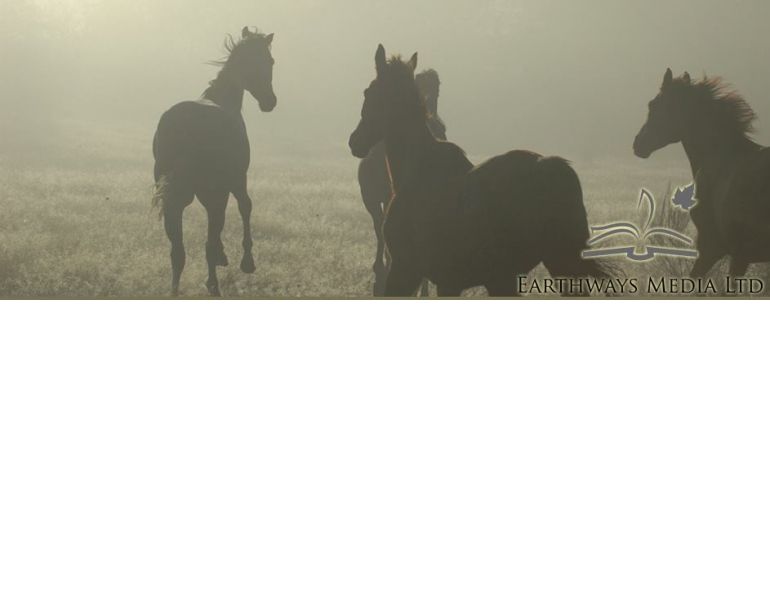By Tania Millen, BSc, MJ
Did you know that a stunning working horse ranch, backed by the Canadian government and open to trail riders, sits on the doorstep of the Rocky Mountains? Yes, it’s true. Ya Ha Tinda Ranch — owned and operated by Parks Canada — is the only federally run horse ranch in the country and marked its 100th anniversary in 2017.
Located about 150 kilometres northwest of Calgary, the ranch stretches along the north bank of the Red Deer River, right next to Banff National Park. Covering close to 4,000 hectares of pristine alpine grasslands and mixed forest, Ya Ha Tinda plays a crucial role: maintaining a dependable string of mountain horses for Parks Canada staff. These horses are used for vital fieldwork in national parks, including trail maintenance, anti-poaching patrols, and supporting hikers. The work demands horses that are calm, sturdy, and intelligent.
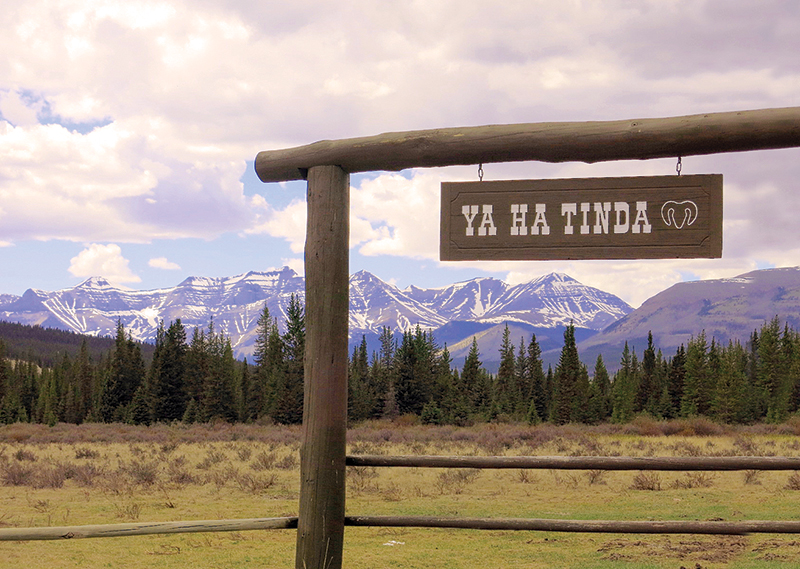
Photo: Tania Millen
The ranch formerly ran its own breeding program, but financial constraints led to a shift. Now, they purchase six to seven Quarter Horse weanlings each year. All are solid-colored geldings from bloodlines known for producing horses with good minds and gentle dispositions.
Rick Smith, who has served as Ranch Foreman for over 15 years, manages daily operations and the care of these valuable horses. “There are bloodlines that we like because they’re quieter, sounder, more stable horses,” he explains. “We like some of the Hancock and Foundation Quarter Horses as they have a little bigger bone, straighter legs, plus have a bit of a wither. They tend to be a little harder when we start them but they quiet down and learn fast.”
Smith continues, “We want something that thinks, rather than balls up when something goes wrong, because our people [Parks Canada staff] aren’t born horseman. We want the horse to stop so there’s time for the rider to react. It takes a really special kind of horse to tolerate that.”
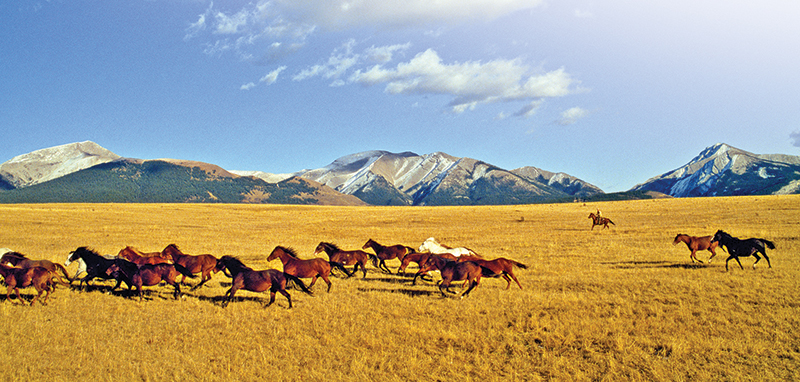
Horses gallop on grazing land at the Ya Ha Tinda Ranch. Photo: Alamy/National Geographic Image Collection
The ranch young stock grow up in natural herds on the rich fescue grasslands that Ya Ha Tinda is known for, and are started in the round pen as two-year-olds. After that, they’re turned out to pasture again until age three when they get some more riding time. The horses get additional mileage at four, then become warden horses at age five.
Two horse trainers live and work at the ranch year-round, and Tom McKenzie is one of them. Every year for the last 10 years, McKenzie has trained about 15 horses to be quiet, well-mannered citizens that can pack and be ridden by wardens and other staff that may be inexperienced horsemen. Although the horses don’t receive any special training, McKenzie says that by the time they leave the ranch to go to work in Canada’s national parks, they’re very well broke. The occasional horse that doesn’t make the grade is sold to a local cowboy.
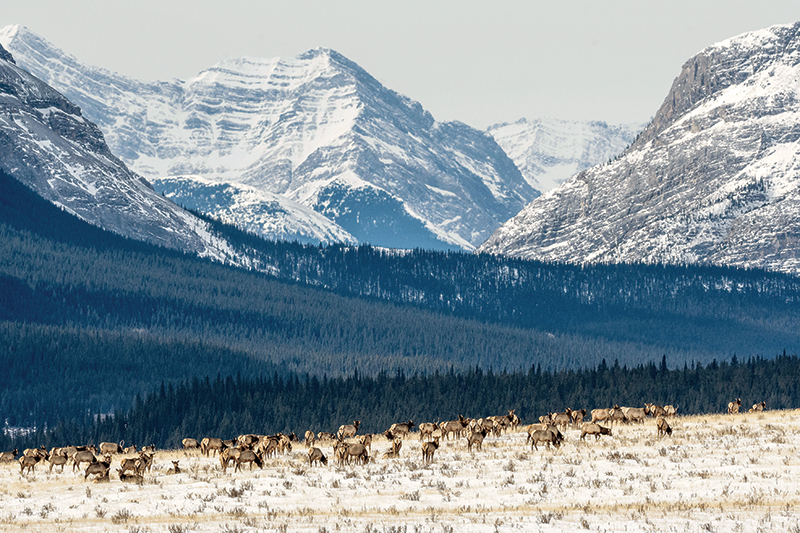
A herd of elk 300 strong before a backdrop of the Rocky Mountains at Ya Ha Tinda Ranch. The elk herd at the ranch is currently 400 to 500 head. The Stoney First Nations people named the Ya Ha Tinda area for its grasslands, abundant wildlife, and mild winters. Photo: Alamy/Leo de Groot
Smith explains further, “Each park has horses assigned to it. The bigger parks – Banff and Jasper National Parks - have a Barn Boss who decides which warden gets what horses. They assign horses, make sure the horses get proper care and shoeing, plus they assess staff all the time and help them out with any problems.”
Many of the horses have long careers, but they all eventually age out of the program. Smith says, “As soon as the horses start losing weight on backcountry trips then we’ll switch them to town horses and we’ll use them for public service jobs like campground patrols, parades, or law enforcement. They’ll be in their early twenties when they retire and then we’ll find homes for them.”
However, the Ya Ha Tinda’s current horse training program and peaceful operations are a long way from its turbulent beginnings. According to Kathy Calvert’s book Ya Ha Tinda: A Home Place, before the Ya Ha Tinda ever became a horse ranch for the federal government, the area was central to political controversy, greed, and misunderstanding.
Many years ago, the Ya Ha Tinda area was named for its “mountain prairie” by the Stoney First Nations people due to its grasslands, abundant wildlife — grizzly bears, wolf, cougar, moose, deer, bighorn sheep, and elk — and mild winters. Although little is known about the area in the early to mid-1800s, historical researchers agree that transitory Stoney First Nations people knew the place well.
In the late 1800s, about the time Treaties 6 and 7 were signed between the Canadian Government and First Nations in southern and central portions of present-day Alberta, the Canadian Pacific Railway was completed through the burgeoning town of Banff, just 70 kilometres south of Ya Ha Tinda. Shortly thereafter, Canada’s first national park – Rocky Mountain National Park (now Banff National Park) – was born. Recognizing the importance of Ya Ha Tinda, the park’s boundaries were then expanded to include the mountain prairie. But when Alberta became a province in 1905, unclear policies regarding jurisdiction over Rocky Mountain National Park and the surrounding land fueled years of federal-provincial tugs-of-war to control the highly desired Ya Ha Tinda.
Related: Solo Horse-Packing Adventures in Canada's Rocky Mountains
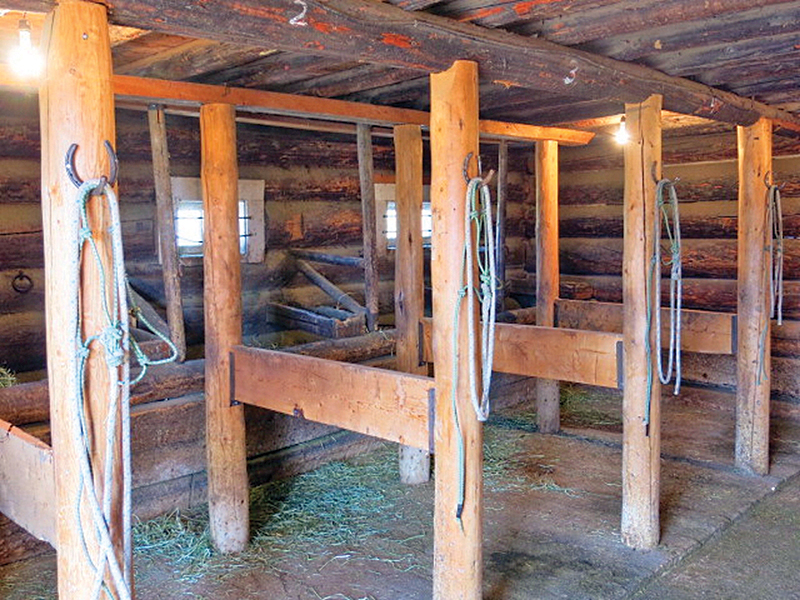
Stalls inside the training barn. Photo: Tania Millen
However, it wasn’t just governments that were captivated by the area. The entrepreneurial Brewster family has owned and operated businesses in Banff since the late 1800s. At that time, Brewsters were keen to acquire lands to support the cattle and horses they used in their dairy business and backcountry outfitting operation. So when a young Stoney man advised the Brewster patriarch about an untouched mountain prairie that had acres of grass ideal for grazing, the Brewster family became intent on acquiring the valuable Ya Ha Tinda lands.
By 1905, Brewsters had an approved, albeit unsigned, grazing lease for land just east of the Ya Ha Tinda. Not ones to let legalities get in the way, they took advantage of the un-surveyed national park boundaries and established their ranch headquarters on Ya Ha Tinda – an area not covered by their questionable lease. Shortly thereafter, Brewster cattle and horses were grazing Ya Ha Tinda and they’d established a three-day horse packing route between Banff and what they called Brewster Ranch.
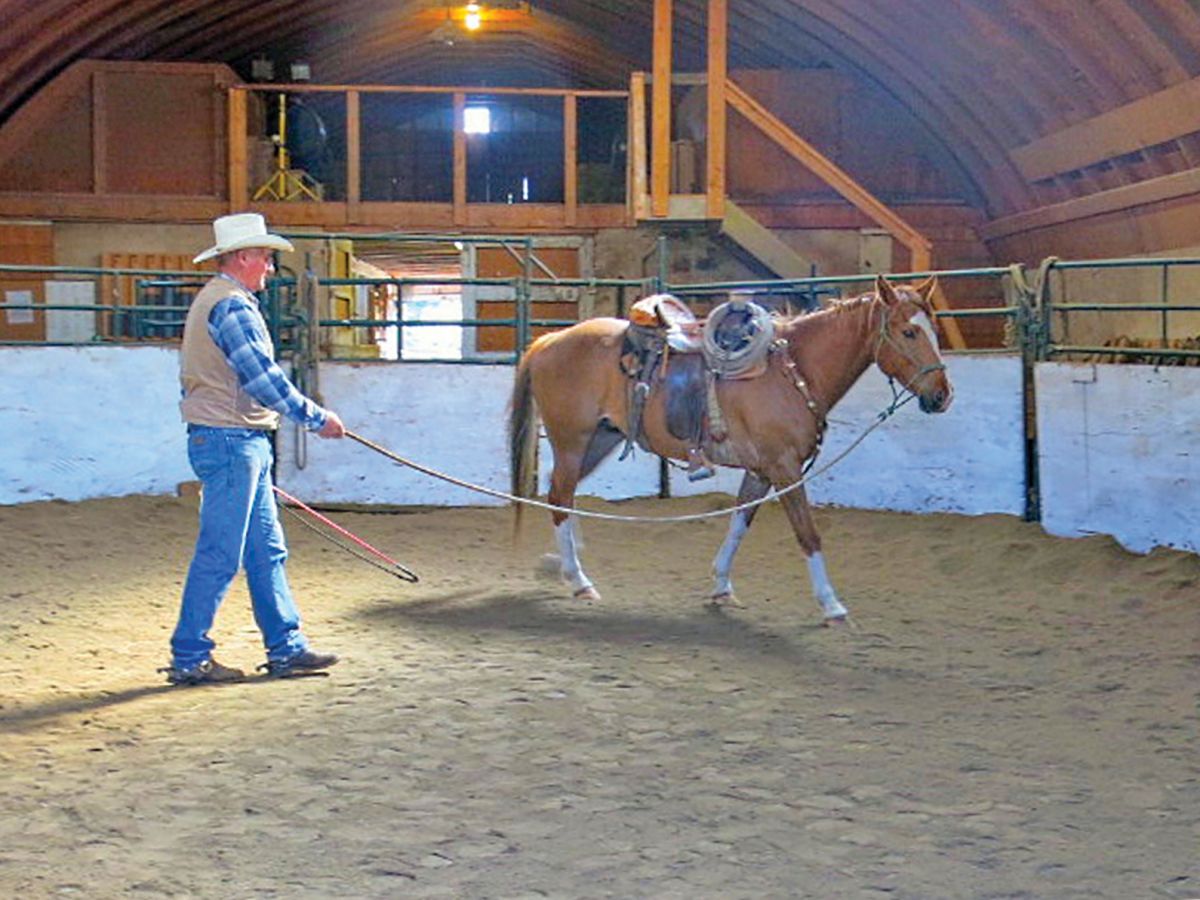
Tom McKenzie, one of two resident trainers, works with a young horse. Each year the ranch buys six or seven solid-coloured Quarter Horse weanlings and lets them grow up together on the ranch grasslands. After being started as two-year-olds they return to pasture, and come back in at ages three and four for more riding time. By age five they are ready to be warden horses. Photo: Tania Millen
A few years later in 1911, the area included in Rocky Mountain National Park was dramatically reduced, park boundaries were altered, and control of Ya Ha Tinda and the surrounding forest lands shifted to the Alberta government. The vast provincial Forest Reserve which was subsequently created along the eastern slopes of the Rocky Mountains — and which surrounds Ya Ha Tinda — was permanently removed from Canada’s national parks and remains provincial territory today.
But the federal-provincial tug-of-war didn’t end there. In 1914, the boundaries of Rocky Mountain National Park were revamped to include Ya Ha Tinda once again, ostensibly to create a warden’s operation centre. This change subsequently allowed Ya Ha Tinda to be owned by Parks Canada as a parcel separate from Banff National Park — as is the case today.
Once Ya Ha Tinda was national park land again, the Brewsters were given an eviction notice. But it was 1917 before the Brewster gang, cattle, and horses left the Ya Ha, and it took most of that summer to round up their 150 free-roaming horses. However, by the end of the year, newly appointed park wardens were living at the fledgling Ya Ha Tinda Ranch, starting what would become the only federally operated working horse ranch in the country over 100 years later.
Related: Hoofprints on the Cypress HIlls
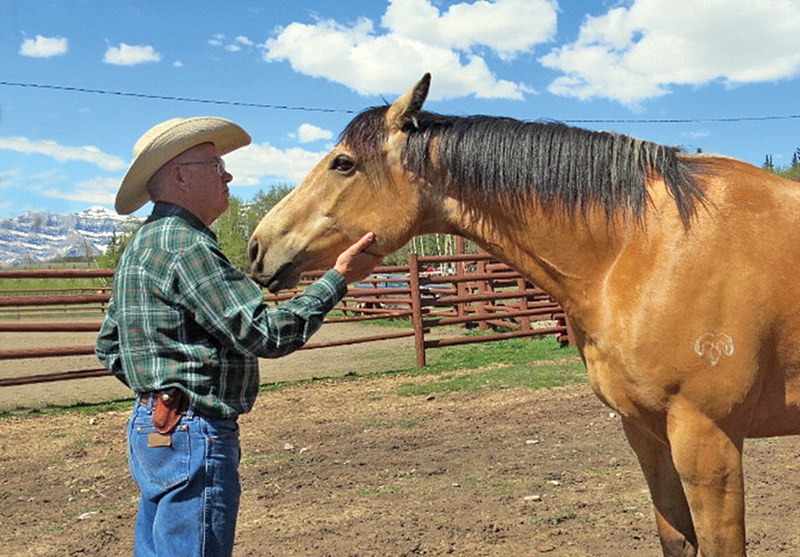
Ranch foreman Rick Smith with a youngster. The ranch needs horses that are quiet and sound, with Hancock and Foundation Quarter Horse bloodlines preferred. Photo: Tania Millen
Since then, much has remained the same but there have been significant changes, too. For example, Ranch Foreman Smith says there used to be about 220 horses at Ya Ha Tinda but Parks Canada funding has been reduced, which means that maintenance of back-country trails, corrals, cabins, and other infrastructure has decreased and the need for backcountry wardens and horses has diminished. So there are currently 110 to 170 horses on the ranch, with numbers fluctuating as horses are sent to Canada’s national parks for work.
Some of Parks Canada’s priorities have changed, too, and activities at Ya Ha Tinda Ranch have changed to reflect that. These days, the ranch is involved with reintroducing bison into Banff National Park, assisting with university-led wildlife research, elk monitoring, hosting continuing professional development (CPD) horsemanship programs for Parks Canada staff and other federal and provincial staff, supporting First Nations events, and welcoming the public — including trail riders and their horses — to Bighorn Campground.
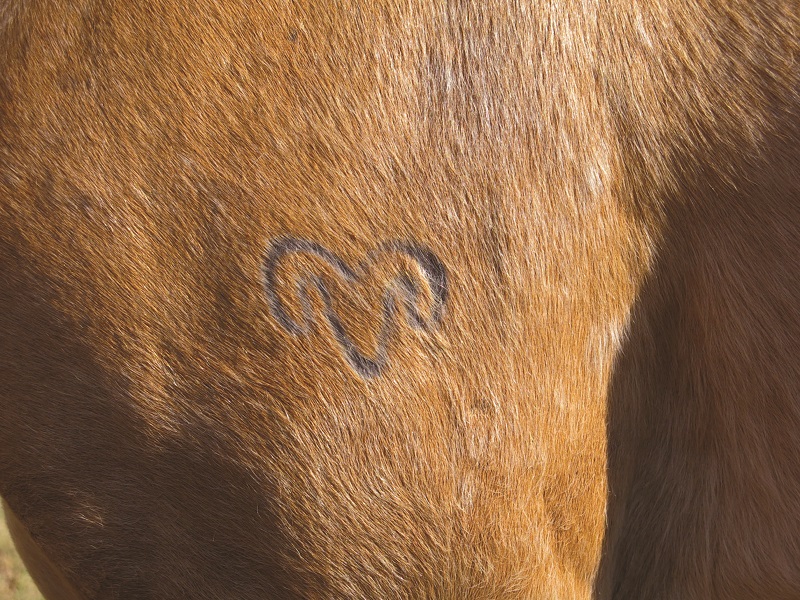
The Bighorn Sheep’s Head brand used on Ya Ha Tinda horses is more than 100 years old. Photo: Tania Millen
Smith says, “We’re kind of on the edge of the bison reintroduction program. We flew the bison in to Banff National Park from the ranch and brought four bison here… so our horses could get used to them. When we first had them, the bison really spooked the older horses – they were sure that they were horse eaters!” He continues, “We use the horses to get to the bison program area [in Banff National Park]… and we’ll be using horses to haze them away from areas outside the park.”
Other wildlife programs have a long history on the ranch, and the elk population has been jointly monitored by government organizations and universities since the 1970s. Smith says, “The ranch has some of the last wild fescue in Alberta and elk calves here have an 85 percent survival rate, which is high for the wild. This whole land is a microclimate and there is rarely snow out here, so they can paw and eat all winter. The elk right now are between 400 and 500 head and we’d like to see that come back up to 900…” He adds, “Science is becoming more and more important here, with ever more university studies. We have a saying at the ranch, “Don’t stand still too long or someone will dart you and put a collar on your neck.”
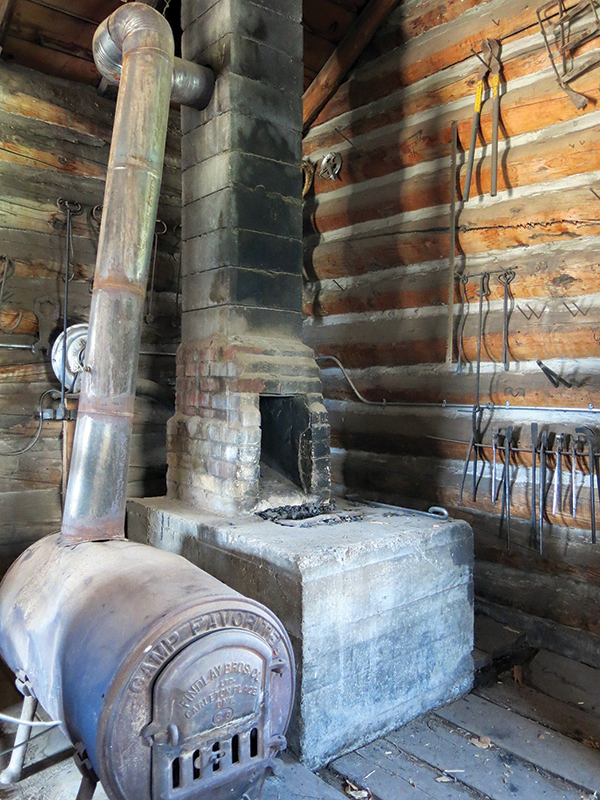
The ranch forge, with farrier tools on the wall. Regular farrier work is done onsite, with outside help if needed during busy times. Photo: Tania Millen
The ranch also makes use of its horses by hosting professional development and horsemanship training courses for Parks Canada and other federal and provincial agency staff. Every spring, there are lessons and training camps at the ranch, to help staff develop their horse skills. Smith explains, “When a person comes into Parks Canada and they’re going to go into the bush, they go through a three-day beginner horse course in Banff. If they’re going to be travelling by themselves, they’ll take a backcountry course. Plus, we have annual CPD [continuing professional development] courses just for them. We only have three to five people on those courses and they’re welcome to come every year to keep learning…” These aren’t the only horsemanship courses held at the ranch - requests from other federal and provincial organizations whose staff need to develop horsemanship skills for their jobs are welcome, too.
Smith continues, “The Bighorn Campground is another part of the ranch. We have an average of 9,000 horse [camping] nights per year there. People hike and mountain bike, too. We don’t charge, but a non-profit [Friends of the Eastern Slopes] looks after the washrooms and Parks Canada staff help with cleanup and maintenance. The public has access to 8,000 acres of the 10,000 acre ranch. It’s a deeded ranch so Parks Canada owns the land and could close the gates, but I doubt we would ever stop people from enjoying the country here.”
Related: Canada's Wild Horses - An Uncertain Future
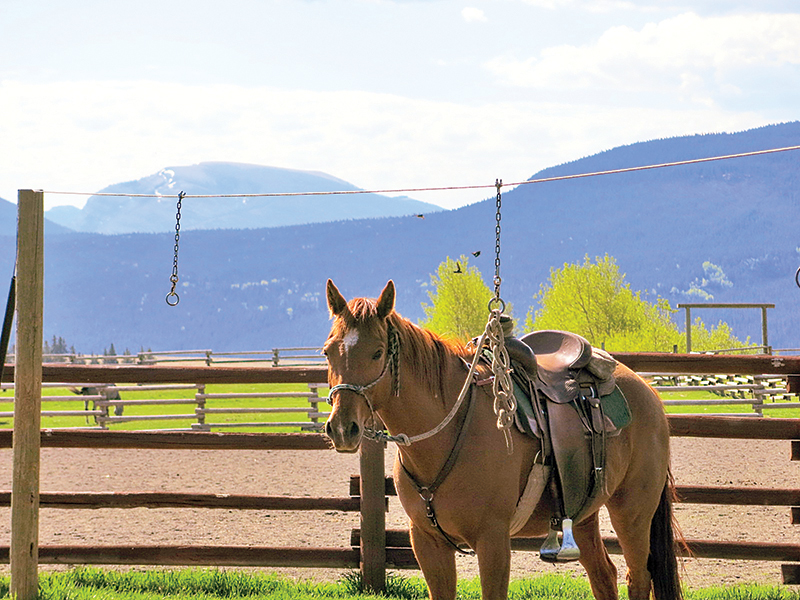
This young horse is learning how to high-line, a necessary job skill for backcountry horses. Photo: Tania Millen
The Ya Ha Tinda Ranch is also well connected to the surrounding First Nations. Smith says, “We have First Nations involvement with the bison and other projects and we’ve staged trips out of the ranch with First Nations. We work with them if they want to hold ceremonies or pack into a certain area. We have a good rapport and we’re open to more involvement, particularly with youth.”
When asked what the future holds, Smith says, “I don’t see any major changes as far as how we [Ya Ha Tinda Ranch] fit into Parks Canada, but I can see us turning into more of a people training facility.” He continues, “Horseback is still the most viable and safe way to do work in the backcountry. But we have to change with the times. Now we can’t find wardens that have horse experience, so we’ve had to revamp our training programs. That’s probably the biggest change in my time.”
To assist with that change, Smith says, “One thing I would like to get done is to build an indoor arena so we can train better in winter. We ride all year-round, but when people come in bad weather and they’re trying to learn, an indoor [arena] would help.”
That’s certainly something that most Canadian riders can understand. But whether Smith gets an indoor arena or not, it’s clear that Ya Ha Tinda Ranch plays an important role in Parks Canada and continues to contribute to Canada as a whole – not only by providing wardens with sane horses but by supporting scientific studies, hosting events, protecting wildlife, and providing public recreational opportunities. First Nations, Parks wardens, government staff, and everyday Canadians have all had the privilege of enjoying and learning from Ya Ha Tinda for over a century. With luck, this stunning high mountain prairie on the edge of the Rocky Mountains will continue to find a place in the hearts of Canadians for the next 100 years.
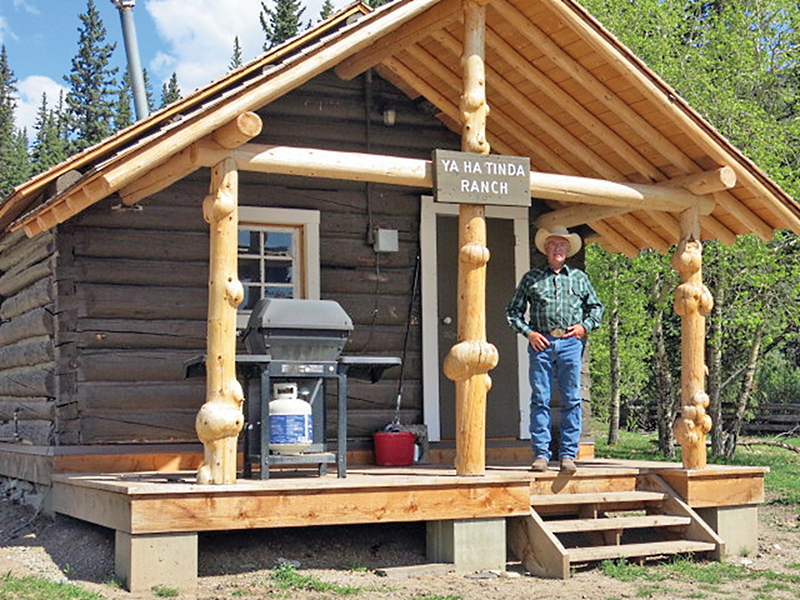
“I can see us turning into more of a people training facility,” says Rick Smith. Because horseback is still the safest and most practical way to work in the backcountry, and not many wardens nowadays have horse experience, the ranch’s training programs have been revamped. Smith adds that an indoor arena would be a big benefit to year-round riding and training at the ranch. Photo: Tania Millen
Want to Ride at Ya Ha Tinda?
Follow these directions:
- Travel approximately 10 kilometres west of Sundre on Highway 584.
- Turn left (south) onto Coal Camp Road and drive 42 kilometres (mostly gravel) to Forestry Trunk Road 734.
- Turn left (south) and follow 734 for three kilometres to a Y intersection.
- Stay right and follow signs 23 kilometres to Ya Ha Tinda Ranch.
- Note that roads are slick when wet.
Bighorn Campground is located on Ya Ha Tinda Ranch, past the ranch gate on the left side of the driveway. The campground has approximately 30 horse campsites, picnic tables, fire rings, outhouses, metal high-line posts, and uncovered standing stalls. Bring your own potable water and plan to water horses from the adjacent Red Deer River. There is no cell service. Campsites cannot be reserved and may only be used for 14 consecutive days.
The campground is operated by the not-for-profit Friends of the Eastern Slopes Association and camping is by donation. The campground has seen over 200 horses at one time and can be very busy on summer weekends. Additional horse-friendly campsites in the area include Eagle Creek located about three kilometres before Ya Ha Tinda Ranch and others in nearby Panther Corners and Upper Clearwater/Ram Public Land Use Zones.
Related: Trekking Horses - What Breeds to Outfitters Prefer?
Related: Riding Horses in Bear and Cougar Country
Check out more Holidays on Horseback.
Main photo: Alamy/Design Pics Inc.



